AI and Space Exploration: How Machines Are Reaching the Final Frontier
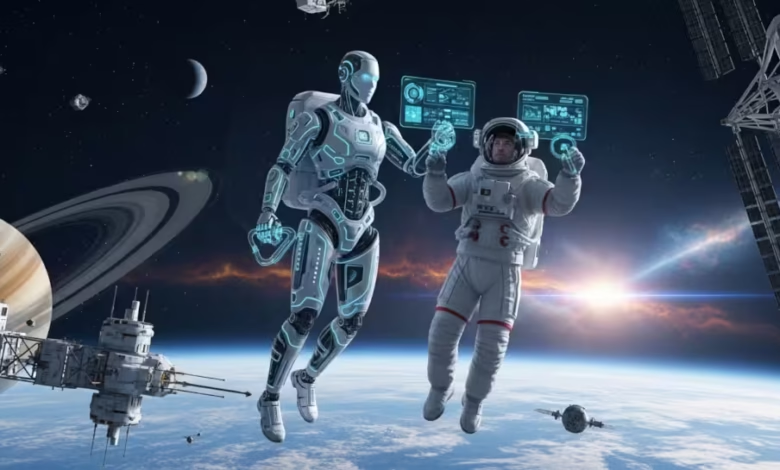
This blogpost discusses the significant role of AI in space exploration, highlighting its impact on autonomous spacecraft and navigation systems. It delves into the technologies that power these innovations, particularly examining Mars rovers as exemplary cases of space robotics. The article showcases how AI enhances the efficiency and safety of interplanetary missions by enabling machines to analyze data, make decisions, and navigate autonomously. Furthermore, it outlines actionable insights and future steps for integrating AI in upcoming space missions. By discussing the advancements in AI in space, this piece emphasizes the transformative potential of artificial intelligence in pushing the boundaries of human exploration beyond Earth.
Exploring The Role Of AI In Space Exploration
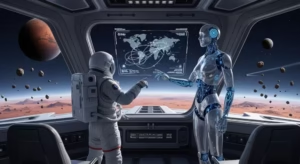
The integration of AI in space has revolutionized how we explore the cosmos. By leveraging complex algorithms and machine learning, AI enables spacecraft to make real-time decisions without waiting for commands from Earth, which is particularly crucial during long missions. This autonomous capability allows for superior navigation, data collection, and analysis, optimizing the learning curve and increasing the efficiency of missions. Furthermore, AI systems can analyze vast amounts of data obtained from space, identifying patterns and anomalies that human analysts might overlook.
Key Contributions of AI in Space
- Enhanced navigation and maneuvering of spacecraft.
- Real-time decision-making capabilities.
- Automated data collection and processing.
- Improved safety through anomaly detection.
- Support for space robotics in performing complex tasks.
- Facilitation of remote operation of planetary rovers.
- Development of predictive models for space weather.
As we delve deeper into the final frontier, the collaboration between human ingenuity and advanced technology proves essential. The use of space robotics equipped with AI is paving the way for autonomous missions that push the boundaries of our understanding. With ongoing innovations, we are not only expanding our reach but also enhancing our comprehension of the universe and our place within it. This fusion of AI and robotics continues to make stellar strides in unlocking the mysteries of space.
The Technology Behind Autonomous Spacecraft And AI Navigation
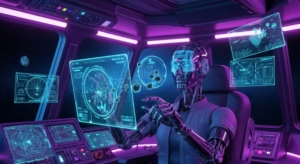
In the realm of space exploration, autonomous spacecraft are becoming increasingly essential for missions that necessitate high levels of precision and efficiency. These spacecraft utilize advanced technological frameworks to operate without constant human intervention. This autonomy not only allows for deeper space exploration but also enhances safety, as human error is minimized. State-of-the-art sensors, communication systems, and data processing units work in harmony to ensure that these machines can navigate the complexities of space effectively.
| Component | Function | Example |
|---|---|---|
| Sensors | Collect data about the spacecraft’s environment | Cameras and LIDAR |
| Actuators | Control movement and navigation | Thrusters and gyroscopes |
| Onboard Computers | Process data and make real-time decisions | Embedded processors |
| Communication Systems | Facilitate data exchange with Earth | Radio transmitters |
The sophistication of these components plays a critical role in ensuring the effectiveness of AI navigation systems. By utilizing machine learning algorithms, autonomous spacecraft can make informed decisions based on the data collected by their sensors, allowing them to adapt to unexpected conditions in space. This capability is crucial for handling the unpredictable nature of space, including obstacles like asteroids or other spacecraft.
Components Of Autonomous Spacecraft
Key components of autonomous spacecraft contribute extensively to their functionality. For instance, sensors not only gather environmental data but also help in obstacle detection, while onboard computers serve as the brain, processing this data and executing navigation commands. Furthermore, effective communication systems allow these spacecraft to receive updates from mission control on Earth, ensuring they remain aligned with mission objectives. The integration of these components underlines the importance of software and hardware working in tandem for successful space missions.
AI Navigation Techniques
AI navigation techniques have revolutionized how autonomous spacecraft operate. By leveraging AI, these spacecraft can conduct complex analyses of environmental data, which enables smarter navigation strategies. Techniques such as predictive modeling, real-time data analysis, and path optimization are commonly employed, allowing the spacecraft to navigate efficiently towards their targets while avoiding potential hazards. The use of these advanced algorithms ensures that even in the vastness of space, the missions can be conducted with increased reliability and success rates.
Steps To Implement AI Navigation
- Identify mission objectives and key performance indicators.
- Select appropriate sensors and data collection tools.
- Develop machine learning models for data analysis.
- Integrate onboard computing systems with real-time communication protocols.
- Conduct simulations to test navigation algorithms under various conditions.
- Implement feedback loops for continuous learning and improvement.
- Finalize operational procedures for mission deployment.
Innovations In Space Robotics: Mars Rovers As A Case Study
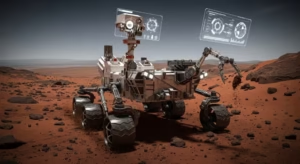
The developments in space robotics, particularly through the design and functionality of Mars rovers, showcase the remarkable advancements made possible by artificial intelligence (AI). These rovers have transitioned from being mere vehicles to complex autonomous systems capable of navigating the Martian terrain, carrying out scientific experiments, and transmitting valuable data back to Earth. This evolution not only highlights the ingenuity behind AI in space but also demonstrates its critical role in expanding our understanding of extraterrestrial environments.
As missions to Mars have become more ambitious, the integration of AI technologies within Mars rovers has proven to be essential. These intelligent systems enable the rovers to make decisions independently, allowing them to adapt to unforeseen challenges on the Martian surface. For instance, when faced with obstacles, the AI software can analyze the terrain and choose alternative routes, ensuring that data collection remains uninterrupted. Such capabilities depict how AI in space is transforming robotic exploration into a more efficient and effective endeavor.
| Mars Rover | Launch Year | Key Innovations |
|---|---|---|
| Spirit | 2003 | Autonomous navigation |
| Opportunity | 2003 | Advanced imaging technology |
| Curiosity | 2011 | Complex scientific analysis capabilities |
| Perseverance | 2020 | Sample collection and caching |
Moreover, the Mars rovers exemplify the multifaceted innovation present in space robotics. They leverage cutting-edge technologies to enhance scientific research, paving the way for future missions. One of the most significant advantages of employing AI in these operations is the ability to conduct real-time data analysis, enabling scientists to make informed decisions based on the findings derived from the Martian environment. Thus, the combination of AI and advanced robotics is set to revolutionize how future explorations are conducted.
Features of Mars Rovers
- Autonomous navigation systems for obstacle avoidance
- High-resolution imaging cameras for detailed surface analysis
- Advanced laboratory tools for in-situ experiments
- Communication systems for real-time data transmission to Earth
- Powerful AI software to process data and make decisions
- Mobility capabilities to traverse rocky and uneven terrain
- Sample collection instruments for geological studies
Effective Use of AI in Mars Missions
The effectiveness of AI in Mars missions extends beyond navigation. It plays a crucial role in analyzing environmental conditions and executing pre-programmed tasks. For example, AI algorithms help manage the environment inside the rovers, adjusting functions based on the prevailing conditions on Mars, such as temperature fluctuations and dust storms. This adaptability significantly increases the likelihood of mission success and data collection, showcasing the profound impact of AI in space exploration.
Key Benefits of Space Robotics
Space robotics offers several key benefits that enhance the overall exploration efforts on Mars. The ability to send AI-driven rovers into environments that are too risky for humans enables scientists to gather detailed information without needing direct human intervention. Additionally, these robots can perform tasks continuously without the need for rest. Thus, as we push the boundaries of our explorations, space robotics stands at the forefront, driving humanity’s pursuit of knowledge beyond our planet.
The Future of AI in Space: Actionable Insights and Next Steps
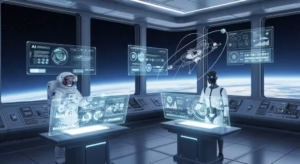
As we stand on the brink of a new era in space exploration, the role of AI in space has never been more crucial. Autonomous spacecraft equipped with advanced artificial intelligence are not just capable of performing routine tasks; they are learning, adapting, and making decisions in real-time. This transformation is paving the way for deeper exploration, from analyzing extraterrestrial environments to executing complex maneuvers without human intervention. The future possibilities are exciting, but they also require careful planning and responsible implementation.
Next Steps for AI in Space Exploration
- Enhance AI algorithms for improved decision-making in dynamic environments.
- Develop robust communication frameworks for real-time data exchange.
- Invest in training programs for engineers on AI applications in space technology.
- Conduct extensive testing of autonomous spacecraft in varying mission scenarios.
- Collaborate with international space agencies to standardize autonomous systems.
- Focus on ethical guidelines for the autonomous operation of spacecraft.
- Monitor and evaluate AI performance to refine operational protocols.
Incorporating these next steps is vital not only to harness the full potential of AI in space but also to ensure that these systems operate safely and effectively. As we advance, it is essential to foster collaboration among various stakeholders. The future of space exploration relies heavily on a shared vision and combined access to technology and knowledge. By placing AI at the core of mission planning and execution, we can elevate our understanding of the cosmos and streamline our exploration efforts.
Ultimately, the trajectory of AI in space signifies a shift toward a more autonomous and efficient approach to exploration. As we continue to see advancements in autonomous spacecraft, the implications extend far beyond mere operational tasks. They open up avenues for unprecedented discoveries and innovations that can redefine our perspective on space. A united effort in refining these capabilities will determine our success in uncovering the secrets of the universe, making this a thrilling time to be engaged in space exploration.
Briefing Document: AI and Space Exploration
1. The Revolution of AI in Space Exploration
AI is fundamentally changing how we explore the cosmos by enabling unprecedented levels of autonomy, efficiency, and safety in space missions. The integration of AI allows spacecraft to “make real-time decisions without waiting for commands from Earth, which is particularly crucial during long missions.” This capability optimizes the learning curve and increases mission efficiency by facilitating superior navigation, data collection, and analysis. AI systems are adept at identifying “patterns and anomalies that human analysts might overlook” from vast datasets.
Key Contributions of AI:
- Enhanced navigation and maneuvering.
- Real-time decision-making.
- Automated data collection and processing.
- Improved safety through anomaly detection.
- Support for space robotics in complex tasks.
- Facilitation of remote operation of planetary rovers.
- Development of predictive models for space weather.
The source emphasizes that “the collaboration between human ingenuity and advanced technology proves essential,” with AI-equipped “space robotics” paving the way for autonomous missions that push the boundaries of human understanding.
2. Technology Behind Autonomous Spacecraft and AI Navigation
Autonomous spacecraft are becoming critical for missions requiring high precision and efficiency, operating “without constant human intervention.” This autonomy enhances safety by minimizing human error and enables deeper space exploration.
Key Components of Autonomous Spacecraft:
- Sensors: Collect environmental data and aid in obstacle detection (e.g., Cameras and LIDAR).
- Actuators: Control movement and navigation (e.g., Thrusters and gyroscopes).
- Onboard Computers: Process data and make real-time decisions (e.g., Embedded processors).
- Communication Systems: Facilitate data exchange with Earth (e.g., Radio transmitters).
AI Navigation Techniques: Leveraging machine learning algorithms, autonomous spacecraft can make “informed decisions based on the data collected by their sensors,” allowing them to adapt to unpredictable space conditions like asteroids. Common AI navigation techniques include:
- Predictive modeling.
- Real-time data analysis.
- Path optimization.
These advanced algorithms ensure missions are conducted with “increased reliability and success rates.”
3. Mars Rovers: A Case Study in Space Robotics Innovation
Mars rovers serve as prime examples of AI’s transformative impact on space robotics. These rovers have evolved into “complex autonomous systems capable of navigating the Martian terrain, carrying out scientific experiments, and transmitting valuable data back to Earth.” AI enables them to “make decisions independently,” adapting to unforeseen challenges like obstacles by analyzing terrain and choosing alternative routes.
Notable Mars Rovers and their Innovations:
- Spirit (2003): Autonomous navigation.
- Opportunity (2003): Advanced imaging technology.
- Curiosity (2011): Complex scientific analysis capabilities.
- Perseverance (2020): Sample collection and caching.
Features of Mars Rovers:
- Autonomous navigation systems for obstacle avoidance.
- High-resolution imaging.
- Advanced laboratory tools for in-situ experiments.
- Communication systems for real-time data transmission.
- Powerful AI software for data processing and decision-making.
- Mobility for uneven terrain.
- Sample collection instruments.
The “effective use of AI in Mars missions extends beyond navigation,” playing a crucial role in analyzing environmental conditions and managing rover functions (e.g., adjusting to temperature fluctuations and dust storms). Space robotics offers significant benefits, including the ability to explore environments too risky for humans and perform continuous tasks without rest.
4. The Future of AI in Space and Next Steps
The future of space exploration is inextricably linked with the advancement of AI. Autonomous spacecraft are moving beyond routine tasks, “learning, adapting, and making decisions in real-time,” opening avenues for “unprecedented discoveries and innovations.”
Next Steps for AI in Space Exploration:
- Enhance AI algorithms for improved decision-making in dynamic environments.
- Develop robust communication frameworks for real-time data exchange.
- Invest in training programs for engineers on AI applications.
- Conduct extensive testing of autonomous spacecraft in various mission scenarios.
- Collaborate with international space agencies for standardization.
- Focus on ethical guidelines for autonomous spacecraft operation.
- Monitor and evaluate AI performance for continuous refinement.
The source concludes that “the trajectory of AI in space signifies a shift toward a more autonomous and efficient approach to exploration.” A united effort in refining these capabilities will be crucial for uncovering the universe’s secrets.
AI is a cornerstone of modern and future space exploration, enabling deeper, safer, and more efficient missions. From autonomous navigation and real-time decision-making to the successful operation of complex robotic systems like Mars rovers, AI is pushing the boundaries of what is possible beyond Earth. Continued investment, ethical considerations, and international collaboration are essential to fully harness AI’s transformative potential in the final frontier.
Homepage / humanaifuture.com
For similar articles, please visit: AI in Science & Technology
🎧 Listen to the Podcast
Want to explore this topic in more depth? Listen to the full podcast for more insights and expert commentary.
▶️ Play on Google DriveNo sign-up needed — just click and listen.
How do autonomous spacecraft utilize AI for navigation?
Autonomous spacecraft leverage AI for navigation by integrating advanced sensors, onboard computers, and communication systems. AI navigation techniques, such as predictive modeling, real-time data analysis, and path optimization, enable these spacecraft to process environmental data, identify potential hazards (like asteroids), and plot efficient routes. This allows them to adapt to unexpected conditions and ensure missions are conducted with high reliability.
What are the key technological components that power autonomous spacecraft?
The key technological components powering autonomous spacecraft include sensors (like cameras and LIDAR) for collecting environmental data and detecting obstacles, actuators (thrusters, gyroscopes) for controlling movement and navigation, and onboard computers (embedded processors) that serve as the "brain" for processing data and making real-time decisions. These components work in conjunction with sophisticated communication systems to facilitate data exchange with Earth.
How have Mars rovers demonstrated the effectiveness of AI in space robotics?
Mars rovers serve as prime examples of AI's effectiveness in space robotics. They have evolved into complex autonomous systems capable of navigating challenging Martian terrain, avoiding obstacles, conducting scientific experiments, and transmitting valuable data back to Earth independently. AI software on these rovers allows them to make on-the-spot decisions, adapt to unforeseen challenges like obstacles or dust storms, and manage internal systems, significantly increasing mission success and data collection.
What are some of the key contributions of AI to space exploration?
AI's key contributions to space exploration include enhanced navigation and maneuvering of spacecraft, real-time decision-making capabilities without Earth commands, automated data collection and processing, improved safety through anomaly detection, and support for space robotics in performing complex tasks. It also facilitates the remote operation of planetary rovers and aids in the development of predictive models for phenomena like space weather.
Why is real-time decision-making by AI crucial for deep space missions?
Real-time decision-making by AI is crucial for deep space missions because the vast distances involved lead to significant communication delays between Earth and spacecraft. Waiting for commands from Earth would severely limit mission efficiency and responsiveness to dynamic environments. AI allows spacecraft to analyze data and make immediate, informed decisions, optimizing operations, ensuring mission objectives are met, and enhancing safety in unpredictable conditions.
What are the future implications and next steps for AI in space exploration?
The future implications of AI in space exploration include deeper exploration, unprecedented discoveries, and a more autonomous and efficient approach to understanding the cosmos. Next steps involve enhancing AI algorithms for improved decision-making in dynamic environments, developing robust communication frameworks, investing in training for AI applications in space technology, conducting extensive simulations, fostering international collaboration for standardization, and establishing ethical guidelines for autonomous spacecraft operation.
How does AI improve safety in space missions?
AI improves safety in space missions in several ways. By enabling autonomous operations, it minimizes the potential for human error. AI systems can continuously monitor spacecraft performance, detect anomalies or potential malfunctions that human analysts might miss, and even adapt to unexpected conditions in space, such as navigating around obstacles like asteroids. This enhanced decision-making and predictive modeling capability significantly increases the likelihood of mission success and protects valuable assets.




